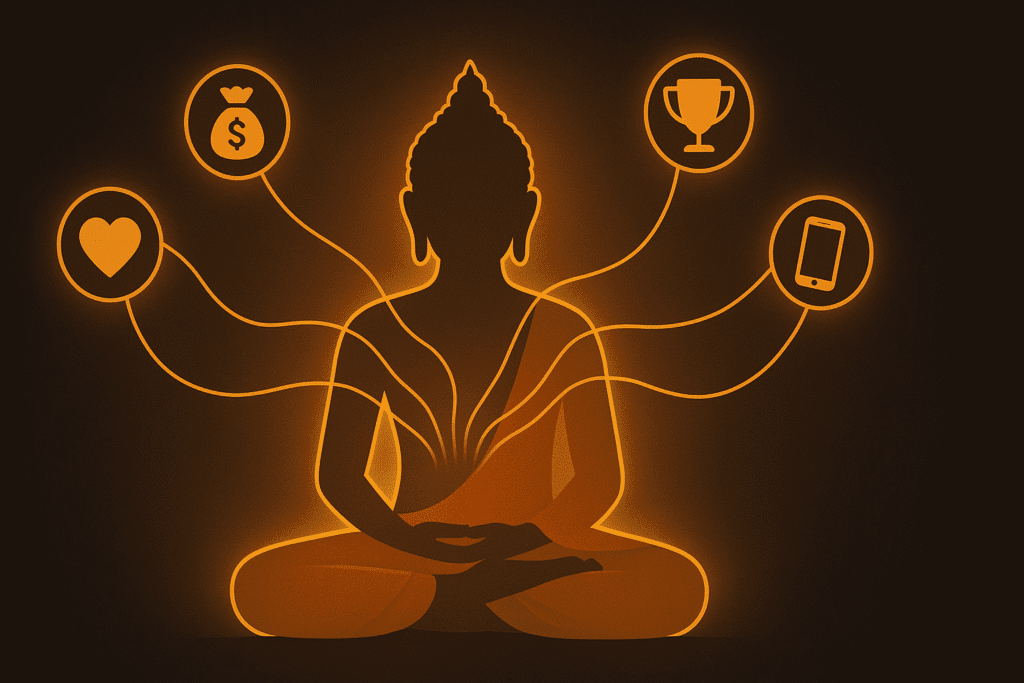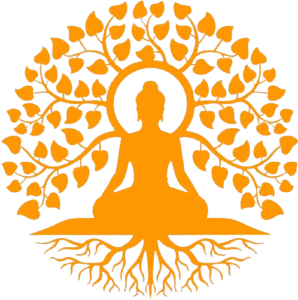
🌿 The Root of Our Restlessness
After recognizing the reality of Dukkha — the unease, dissatisfaction, and emotional friction of life — the Buddha asked a deeper question:
Why do we feel this way?
The answer was not hidden in the heavens or in fate. It was right here — in the human mind itself.
The Buddha called this second truth Samudaya, meaning the origin or cause of Dukkha.
💭 What Causes Dukkha?
The Buddha saw that our stress and tension arise from craving — the endless wanting, clinging, and resisting that run our lives.
“From craving arises suffering; from the ending of craving, suffering ceases.”
— The Buddha (SN 56.11)
Craving (taṇhā in Pāli) has many faces. It’s not only desire for objects or pleasure — it’s also the inner demand that things must be a certain way.
🌍 Craving in Modern Life
We don’t need to live in ancient India to see Samudaya in action.
It’s alive in our everyday thoughts, habits, and emotions.
Here’s how craving quietly creates unease in modern life:
- Endless Scroll Craving: Refreshing social media again and again, searching for approval or validation.
- Success Craving: Believing peace will come only after the next promotion, car, or achievement.
- Relationship Clinging: Holding on too tightly, fearing loss, or trying to control others’ behavior.
- Control Craving: Wanting life, people, and emotions to obey our expectations.
- Avoidance Craving: Trying to escape discomfort through distraction, food, or entertainment.
All these come from one root: the mind’s insistence that “I will be happy only when…”
🪷 The Three Forms of Craving
The Buddha described three main types of craving (taṇhā):
- Kāma-taṇhā — Craving for Sensual Pleasure:
The pull toward comfort, pleasure, taste, beauty, or stimulation. - Bhava-taṇhā — Craving for Becoming:
The urge to become something — more successful, admired, spiritual, or powerful. - Vibhava-taṇhā — Craving for Non-Becoming:
The opposite — wishing to avoid, escape, or destroy what we dislike (pain, responsibility, failure).
These cravings keep the mind in constant motion — chasing, resisting, hoping, fearing.
🌼 Observation, Not Suppression
The Buddha did not teach us to suppress desire by force or guilt.
He taught us to see it clearly — to notice how craving arises, how it feels, and how it fades when we don’t feed it.
It’s not about hating desire; it’s about understanding it.
When you observe craving without reacting, it loses power naturally.
“When a wise person sees craving as it is, craving ceases.”
— The Buddha (SN 12.20)
🔍 How to Observe Craving in Your Own Life
Try these daily reflections to see Samudaya in action — calmly, without judgment:
- Notice Wanting: When you feel uneasy, pause and ask: “What am I wanting right now?”
- Feel It: Observe where it appears — in your chest, throat, or mind.
- Name It: Is it craving for approval, control, comfort, or escape?
- Stay Aware: Watch how craving feels tight and restless — and how it softens when seen clearly.
- Reflect: Notice that peace comes not from getting everything, but from releasing the need to get.
🌅 Why Understanding Samudaya Brings Freedom
Seeing craving clearly is an act of wisdom, not judgment.
The moment we understand “this is craving”, we stop being its prisoner.
Instead of being pushed by desire, we gain the space to choose — to respond with awareness rather than react in habit.
This is where real freedom begins — not from changing the world, but from understanding the mind that clings to it.
🌻 Closing Reflection — The End of Endless Wanting
The Second Noble Truth is not about rejection — it’s about seeing the pattern that creates our inner tension.
When you notice craving rise and fall, you begin to sense something deeper than it — a quiet presence that doesn’t need to chase or control.
That awareness is the seed of peace.
The more we see clearly, the less we are bound.
Freedom begins not when we get everything we want — but when we no longer need to.
🪷 Understanding Samudaya — Practical Q&A
1️⃣ What is Samudaya?
Samudaya means the origin or cause of Dukkha — the stress, tension, and dissatisfaction we feel in life. The Buddha explained that this cause is craving (taṇhā) — the mind’s constant “wanting” or “not wanting.” It’s the energy that says, “I’ll be happy only when things go my way.”
2️⃣ Does Buddhism say desire is bad?
No — not all desire is harmful. Healthy desires, like learning, growing, or helping others, come from wisdom. Samudaya points to craving born from attachment — when our peace depends on something outside us. That kind of desire leads to restlessness, not joy.
3️⃣ How does craving create suffering in daily life?
Because craving never ends. The moment one desire is fulfilled, another takes its place.
We chase comfort, control, approval, and success — but the mind stays tense.
Craving keeps us running, but never resting.
4️⃣ What are examples of craving in modern life?
Answer:
Checking your phone again and again for messages or likes.
Feeling anxious when someone disagrees with you.
Wanting others to behave exactly as you expect.
Shopping or eating to escape boredom or sadness.
Needing constant achievement to feel worthy.
These moments aren’t sinful — just chances to observe the craving cycle.
5️⃣ Are attachment and craving the same thing?
They are closely related. Craving (taṇhā) is the thirst — the urge to get, keep, or avoid something.
Attachment (upādāna) is when we hold on tightly and say, “This is mine. I can’t lose it.”
Craving leads to attachment; attachment strengthens craving. Together, they fuel Dukkha.
6️⃣ How can I recognize craving when it arises?
You can notice craving by its feeling of tension.
Ask yourself:
“What am I wanting right now?”
“What am I afraid of losing?”
Craving always feels tight, rushed, or restless — as if peace depends on getting or avoiding something.
7️⃣ If craving causes suffering, should I try to stop wanting anything?
No — trying to suppress desire is another form of craving!
The Buddha’s way is understanding, not suppression. When you observe craving calmly, without acting on it, it weakens naturally. Peace arises not by fighting desire, but by seeing it clearly.
8️⃣ How does mindfulness help reduce craving?
Mindfulness lets us catch craving the moment it starts. When you pause and notice the urge — to check your phone, to argue, to control — awareness interrupts the habit. You realize, “I don’t have to obey this impulse.” That moment of awareness is freedom beginning.
9️⃣ Can I live in the modern world without craving?
Total freedom from craving takes time, but you can reduce it greatly.
Even small awareness changes everything. You still enjoy life, but without being trapped by it.
Pleasure becomes lighter, relationships become freer, and peace becomes more stable.
🔟 What happens when craving ends?
When craving fades, Dukkha fades. The mind becomes quiet and content — not because it owns everything, but because it needs nothing to be at peace. That is the beginning of freedom, which leads to the Third Noble Truth: Nirodha — the end of suffering.
